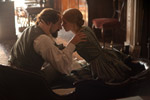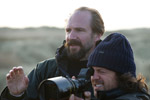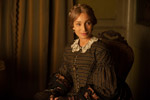Kristin Scott Thomas and Felicity Jones The Invisible Woman
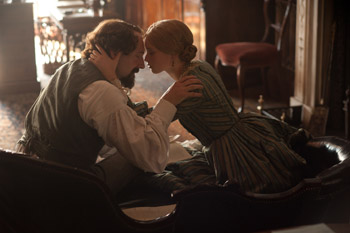
Kristin Scott Thomas and Felicity Jones The Invisible Woman
Cast: Ralph Fiennes, Felicity Jones, Kristin Scott Thomas
Director: Ralph Fiennes
Genre: Biography, Drama, Romance
Rated: R
Running Time: 111 minutes
Synopsis: It is 1885 and Nelly Wharton Robinson, a woman in her late 30s, is living with her husband, George Wharton Robinson, and their sixyear old son Geoffrey in Margate. They enjoy a happy and bustling life running a school for boys of which George is the headmaster. Nelly, who loves the theatre, stages elaborate plays with the schoolchildren, including one called No Thoroughfare: A Drama in Five Acts, written by Charles Dickens and Wilkie Collins. Rather incongruously, her production stars Geoffrey as a lion. But Nelly is hiding a secret. She takes long walks on the beach, lost in her thoughts, oblivious to the melancholy of an English coastal resort in winter. On her return her distracted air catches the attention of Reverend William Benham at the play's dress rehearsal. When he points out there is no lion in the play he is intrigued by her insistence the two playwrights would not have minded her taking such dramatic license.
During the rehearsal, Nelly's thoughts drift to another time. It is 1865 and Nelly, then in her mid-20s, is on a train. Just as quickly, it is 1857 and the 18 year-old Nelly is attending rehearsals with her mother, Catherine Ternan, and older sisters Fanny and Maria, in Manchester at the Free Trade Hall. They have been hired to appear in The Frozen Deep, written by Wilkie Collins, and directed by and starring the famous Charles Dickens. The Ternan women are all renowned actresses, although Nelly, the youngest, shyest and prettiest, does not possess the acting talents of her mother and sisters.
Every aspect of the cheerful, noisy rehearsal is overseen with great skill by Dickens, revealed to the Ternan women as a wonderfully charismatic man in his mid 40s. They meet his good friend Wilkie as well as his family and children, including his wife Catherine Dickens. She sits apart from all the activity, looking tired and disinterested.
After a successful performance, Dickens hosts an exuberant celebration. The Ternan family are charmed by the singing and dancing long after his wife and many of the company have retired to bed. Nelly and Dickens share a moment watching the dawn creep in.
Back in 1885 and Nelly is in the schoolhouse library with Benham. She owns several signed copies of Dickens novels, a writer her husband believes Nelly knew as a child. But Benham's curiosity is piqued again as he glimpses a tiny lock of baby hair within the pages of an original version of The Frozen Deep. It is hastily hidden by Nelly.
In bed later that night, after making love to her husband, Nelly's mind wanders again to 1857. She is attending a reading of David Copperfield by Dickens with her family. They are flattered by the attention he pays them, particularly Nelly, who admits to him she has read the novel twice.
As the affection between the Ternans and Dickens grows, so Dickens becomes increasingly distant from his wife. The Ternans attend Doncaster Races with Dickens and Wilkie. When Dickens is mobbed by adoring race-goers, they recognise the true extent of his celebrity.
Unpacking at their modest London home, Mrs Ternan discovers Nelly's signed copy of David Copperfield and realises the feelings developing between Nelly and Dickens. When Dickens later visits Park Cottage, Mrs Ternan tells him she is conflicted. She is fearful her daughter will not be able to earn a living as an actress but neither does she want Nelly to risk her reputation as the mistress of a wealthy married man.
Back in 1885, Benham has joined Nelly on the beach. She admits she was 18 when she first met Dickens and that she was an also an actress. Benham realises what she is telling him, and that it is something she has kept from her husband, or so she believes.
In an attempt to cheer her up they take Nelly to the home of Caroline Graves, Wilkie's widowed mistress. But Nelly is unamused by their living arrangements. The evening ends with both Nelly and Dickens consumed by a tumult of conflicting emotions and a new understanding of who the other is. Dickens' marriage to a devastated Catherine publically unravels with a letter announcing their separation he sends to The Times. It has a tremendous impact on both his family and the Ternans. Dickens tries to explain to Nelly why he did what he did and compares himself to the flawed, unheroic Pip of Great Expectations, the novel he is working on. Nelly suggests they go away together.
Following an idyllic time together in France, Nelly falls pregnant. But the pregnancy ends tragically in a stillborn baby boy and Nelly is grief-stricken.
They leave France and once back in England board a train to London. Dickens is busy working on Our Mutual Friend as Nelly watches the Kent countryside speeding past. Suddenly the train violently buckles and the world is upturned. Nelly awakes on a grassy verge, slightly injured. A distraught, unharmed Dickens tends to her before she sends him away to help the injured and to keep his travelling companion a secret.
Twenty years later in 1885, preparations for the school performance are in full swing. But Nelly is not there. Instead, she is talking with Benham in a graveyard, where he reveals he knows her real name, Ellen Ternan. With relief Nelly tells him about her life with Dickens, as if trying to make sense of it herself.
Her state of mind much improved, Nelly returns to the schoolhouse, slipping in beside her seemingly unsuspecting husband. Broaching the subject of Benham and Dickens, they are interrupted by a roar of a lion as Geoffrey rushes up to them and is tenderly embraced. Holding hands, his parents watch Geoffrey's joyful performance which is greeted with ecstatic applause.
The Invisible Woman
Release Date: April 17th, 2014
Breathing Life Into The Invisible Woman
Just after Ralph Fiennes finished making his directorial debut Coriolanus, in which he had also starred, Gabrielle Tana, his producer on that film, approached him with a new directing project in February 2010.
The Invisible Woman was being developed by Stewart Mackinnon of the UK's Headline Pictures, who owned the film rights to Claire Tomalin's acclaimed 1990 biography of the same name. Her book was about the young actress, Ellen Ternan, who had had a long, secret love affair with Charles Dickens and reinvents herself after his death.
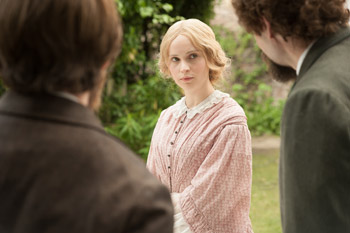 Stewart Mackinnon was developing the project with Christine Langan, the head of BBC Films, and the gifted screenwriter Abi Morgan, whose credits include Shame, The Iron Lady, and BBC TV series The Hour.
Stewart Mackinnon was developing the project with Christine Langan, the head of BBC Films, and the gifted screenwriter Abi Morgan, whose credits include Shame, The Iron Lady, and BBC TV series The Hour.
Christine Langan brought on board Gabrielle Tana as lead producer and Ralph Fiennes subsequently joined as director.
He immediately began working on the script with Abi Morgan and the project gained momentum 'It took about nine months to all come together while we working on the script, casting, putting together our ideal crew," says Gabrielle Tana, who first worked with Fiennes on Saul Dibb's sumptuous 2008 period drama The Duchess. 'I was busy raising the money at the same time."
The Invisible Woman is a co-production between Headline Pictures and Tana's Magnolia Mae Films, with development and production funding from BBC Films and the BFI Film Fund, as well as private US financing. London-based WestEnd Films co-financed the project and is handling worldwide sales. Lionsgate UK, which
released Coriolanus, has UK rights, and E1 Entertainment will handle the film in Australia.
Until she met Ralph Fiennes, Abi Morgan had been grappling with different versions of the screenplay, including the introduction of several fictitious elements. Ralph Fiennes suggested pulling it back to what Stewart Tomalin had unearthed in her book.
Although he doesn't write himself, Ralph Fiennes brought an interesting extra dimension to the collaboration with Abi Morgan. 'It's very exciting when you work with an actor-director because he could literally get up, be very physical and move around the room," says Abi Morgan. 'It's an incredible privilege to work with someone who is not only a great director but one of the country's leading actors and to see his process. That really informed the writing process. Most directors aren't very good at saying the lines. He was very good at visualising and understanding how a scene would play. He would be brilliant at stripping back material as he would know how little an actor actually needs."
Ralph Fiennes and Abi Morgan talked often with and sought advice from Stewart Tomalin. Through her biography it was Stewart Tomalin who had been the first person to breathe life into the figure of Ellen 'Nelly" Ternan.
'It is an amazing story. It is the story of this young woman who was taken up by Dickens," Stewart Tomalin enthuses. 'But still more fascinating was what I found out which was that when Dickens died, she reinvented herself. She turned herself into a lady and she presented herself as 10 years younger. How extraordinary to be able to carry that off. What interested me is she seemed to represent a whole lot of women in the 19th Century who were hidden, who had these hidden lives. And that's why I called it The Invisible Woman. Nelly, because Dickens had taught her how to deceive in a way, rose up and wouldn't accept she was going to be hidden forever and recreated herself."
Stewart Tomalin was hugely supportive of the project but removed herself from the actual screenwriting. 'Abi Morgan said to me, -do you want to come and work with me?' and I said, -No no no, you're the screenwriter, I just wrote the book'," Stewart Tomalin explains. 'I have made many, many, comments on the script and they have listened to me but I wouldn't dream of imposing my ideas or my will."
Abi Morgan decided to structure the screenplay around a series of 'small tragedies and moments of catalyst" depicted in Stewart Tomalin's book, which, for her, defined the affair. The two most significant were Stewart Tomalin's discovery Dickens and Nelly had conceived a child together and the effect this had on them as a couple, and the derailment of the train in which they were travelling at Staplehurst in Kent in 1865. Nelly was injured but was left alone by Dickens as she realised the impact of being in an illicit relationship with the most famous man in the world.
'It was very important to love the book and adore the book but also to clearly say we are going to tell one story, the arc of their love story," Abi Morgan explains. 'And we counterpointed that with a present-day narrative of the moment she reveals her secret."
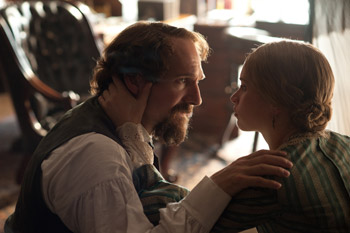 Portraying Charles Dickens
Portraying Charles Dickens
Ralph Fiennes did not intend to play Charles Dickens himself at first. But if he had doubts, others did not. 'I kept saying to him, -You must play Dickens! You were born to do it!" recalls Stewart Tomalin.
'For me it was always going to be Ralph Fiennes but it was just a process of persuading him," smiles Abi Morgan. 'When we were working on the script, I was constantly saying -and this is when you will….' and he'd go -Well you don't know that.' and I'd say -Of course not' and I'd say, -Well, Daniel Day- Lewis would be amazing in there', which is always a good thing to say to an actor because they're a bit, -hmmm'."
'I was undecided for a long time," Ralph Fiennes admits. 'Until after quite a few months of working on it, I felt, despite knowing it would be very difficult, that I couldn't resist playing him."
The Charles Dickens revealed in The Invisible Woman is a man possessed of ferocious energy. Not only does he juggle a young mistress with marriage and 10 children, but he successfully maintains a vigorous writing regime and roles as a journalist, actor, theatre director, social campaigner and celebrated bon vivant.
'In a funny way, that probably helped me because it was very Dickens to be organising people and doing everything," says Ralph Fiennes, of the enormity of the role he undertook as director and lead actor. 'He was in control of everything."
As too was Ralph Fiennes. 'It was Herculean what he did," says Gaby Tana. 'Ralph Fiennes was so prepared and so diligent. He immersed himself in the world of Dickens, which he didn't really know. He hadn't read any Dickens before this. He is so interested in all of the details."
The cast was thrilled to have an actor of the calibre of Ralph Fiennes as director. He won a BAFTA for his role in Schindler's List in 2004 and has since been nominated a further four times, including for the best debut by a British writer, director or producer for Coriolanus in 2012. He has also been nominated twice for an Academy Award® for Schindler's List in 1994 and again for The English Patient in 1997.
'He will not let anything go, he doesn't let you take the easy option," says Felicity Jones, the rising UK star who was cast as Ellen Ternan. 'You'll be doing 15, 20 takes as he always wants to get something completely honest."
'He's like a laser, he won't let anything slip by," says Amanda Hale, who plays Nelly's middle sister Maria Ternan. 'His emphasis is so much on performance, which is quite rare."
For Kristen Scott Thomas, who plays Nelly's mother, Catherine Ternan, it was the third time she had worked with Ralph Fiennes following their famous on-screen love affair in The English Patient, for which they were both nominated for Oscars.. 'I enjoyed being directed by Ralph Fiennes as much as I enjoy acting with him," she says. 'I'm in awe of what he's doing. He's keeping it all in the right place, with everything ticking over and at the same time manages to remain one of the team as far as the actors are concerned."
Abi Morgan compares Ralph Fiennes' dynamism with that of Dickens'. 'There is this pulse that runs through Dickens' novels and runs through the man," she explains 'When you meet Ralph Fiennes, he's hugely charismatic and yet he can choose how high or how low he can put up the light-bulb. He can be frightening, he can be tender and he can gear-change in the way Dickens does. He can be co-writer, he can be director, he can be actor, and he can be production designer. He doesn't jump through those roles, he flows, and it flows through him."
For Ralph Fiennes, it was very important to convey Dickens' vitality, his love of life, and the sheer force of his charm. He points to the cheerful organised chaos of the rehearsal of The Frozen Deep, the first scene in which Dickens' appears, as crucial to this depiction. He describes Dickens as a man of 'extraordinary imaginative power and range".
Like everyone working on the film, both Ralph Fiennes and Abi Morgan were drawn to the complexity of Dickens, a revered man but one whose behaviour towards his wife was at times shocking.
'I knew people might not like him, that didn't worry me," says Ralph Fiennes. 'He's a huge soul. And, as a man, deeply fallible. We can jump to judging him very quickly. Abi and I tried to show in simple scenes, the sense of a marriage, it's not people hating each other, but the spark has gone and it's sort of a matter of fact-ness. I can't help thinking Dickens was looking for a real connection with a female which he hadn't
found with his wife and suddenly decided he could have with Ellen Ternan. I think he saw Ellen Ternan and she was like the Jungian ideal he had always written about. There she was, and that was that. He had to have her."
Abi Morgan believes a creative chaos may have been at work, compelling the 45 year old Dickens to fall in love with an 18 year-old actress. 'Your 40s are interesting," shemuses. 'There is a compulsion to shake it up sometimes and there's a compulsion to take yourself as a person to different places because that informs your writing. That's what draws creative people to catastrophe and to drama sometimes because it's also where there energy starts to burn and where they get a lot of creative material from."
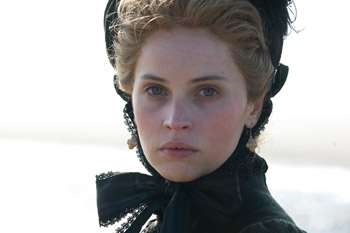 Directing himself forced Ralph Fiennes to be unflinching when considering his performance. 'I have to look at myself, sit with my editor, choose the take," he says. 'It's an endless, wonderful, beautiful puzzle what it is to make a performance. No one moment is ever the same. As the director you are looking and waiting to catch the wave where it all becomes one thing. How you do that, I don't know. You can push, pull, cajole, tease, be brusque, be loving or be flattering or do nothing and just wait. It's probably best to just wait, which is hard on a film set."
Directing himself forced Ralph Fiennes to be unflinching when considering his performance. 'I have to look at myself, sit with my editor, choose the take," he says. 'It's an endless, wonderful, beautiful puzzle what it is to make a performance. No one moment is ever the same. As the director you are looking and waiting to catch the wave where it all becomes one thing. How you do that, I don't know. You can push, pull, cajole, tease, be brusque, be loving or be flattering or do nothing and just wait. It's probably best to just wait, which is hard on a film set."
One person who found Ralph Fiennes' multiple roles a slight challenge was the Oscar winning make-up and hair designer Jenny Shircore, who had just worked with Ralph Fiennes on Mike Newell's Great Expectations in which he had starred as Magwitch. 'To get him to sit still while I checked something was not as easy as it normally is because he was always thinking about the next shot and wanting to be there," she says.
The Troupe: Casting The Invisible Woman
'Ralph Fiennes has got a real barometer for finding good talent," says Abi Morgan. 'You have the incredible on-screen talent of Kristin Scott Thomas, Felicity Jones, Tom and Ralph Fiennes himself, but you also have a huge ensemble of actors who aren't as well known who he is bringing to the fore. He's got a real eye."
The British film and theatre actress Felicity Jones was cast as Ellen Ternan even before Ralph Fiennes decided to play Dickens himself. Felicity Jones is one of the UK's hottest new acting talents following her award-winning role in Drake Doremus' Sundance 2011 hit Like Crazy and more recently Doremus' Breathe In, opposite Guy Pearce.
'I wanted someone who had great interior resources," says Ralph Fiennes of Felicity Jones. 'Felicity Jones' great gift is she's very intelligent and the camera reads a sense of other things happening inside of her."
In Felicity Jones' accomplished hands, Nelly is an astute, self-possessed young woman. 'The older, Margate Nelly is someone who's got this secret she is sitting on and Felicity Jones has an amazing ability to suggest that," says Ralph Fiennes. 'And as the younger Nelly she has these moments when she laughs and is free, has a sense of humour, has a vulnerability. This is very much Felicity Jones' creation."
Felicity Jones was captivated by the script and then by Stewart Tomalin's book. 'I felt I had to understand this woman who had been almost entirely eclipsed by history," the actress says of Ellen Ternan. 'When Dickens meets Nelly he's confronted with someone who I felt wasn't a particularly open book. She's quite a closed character.
There's something very unknowable about her and from the moment he first meets her he develops an obsession with her."
Two of Ralph Fiennes' close friends and colleagues also joined the cast: Kristen Scott Thomas, who Ralph Fiennes always had in mind for Catherine Ternan, and Tom Hollander, his great friend, who he cast as Dickens' great friend Wilkie Collins.
'He's extraordinarily inventive," says Ralph Fiennes of Hollander. 'His little insights into parts are always so delicate and amusing. He was also an amazing friend to me on set because under pressure he was extraordinary as an ally."
The director worked with UK casting directors, Leo Davis and Lissy Holm, to discover actors with which he wasn't familiar. 'It forces you to define who a character is," says Ralph Fiennes of the casting stage. 'But at the same time remain open to meeting different actors and suddenly realising, -I hadn't thought of that but that person would be rather great'."
One of those was Joanna Scanlon who plays Catherine Dickens. She endowed the part of subdued and betrayed wife with a quiet dignity and intelligence. The delicacy she brought to her performance was crucial to the tone of the entire film.
'To write about a man who is at time monstrous and still in part to retain sympathy is of course largely in part thanks to Ralph Fiennes but also to Joanne Scanlon's performance as Catherine Dickens," offers Abi Morgan. 'You feel her pain but you can see this is a woman who really loved Dickens, admired him and is caught by his plight. As much as she feels pain for herself she feels pain for his situation. That goes beyond anything I have written. That is purely Jo's performance."
The camaraderie and vividness of the Victorian theatrical world that so appealed to Dickens was replicated on-set by the cinematic troupe put together by Ralph Fiennes. 'It was always good fun on set," says Felicity Jones." Ralph Fiennes was very good at creating an environment where people didn't feel threatened or intimidated. People wanted to do the best they could do."
Creating the world of Dickens and Nelly: Production Design; Costumes; Hair & Make-up; Locations
The look of 19th Century England was fastidiously researched and recreated for the film which shot for 10 weeks throughout the early summer of 2012. Fiennes felt strongly that the way into the period drama for the audience was to make it appear as real as possible. This belief encompassed the type of wallpaper and the weight of the dress fabric, as well as ensuring every letter burnt by Dickens in one scene is authentic and, folded as it would have been.
The crowd even shouted the actual names of the horses that raced at Doncaster on Derby Day in 1857. 'Subliminally, if everything is very detailed, audiences feel the world," Ralph Fiennes explains.
One of the major reference points for this was William Powell Frith's famous painting 'The Derby Day" of circa 1850. 'We were going over it with a magnifying glass," says production designer Maria Djurkovic. 'Somebody with a lobster here, a dog on a lead there. We have tried to be as accurate as we can without being slavish to it. It's a balance, that's what's fun about it."
Ralph Fiennes assembled an impressive group of UK heads of department. In addition to the award-winning Djurkovic, who picked up prizes from both the British Independent Film Awards and the European Film Academy for her work on the 2011 Cold War thriller Tinker Tailor Soldier Spy, Fiennes brought in Rob Hardy BSC as director of photography after seeing his work on James Marsh's 2012 film Shadow Dancer. Fiennes had also worked with costume designer Michael O'Connor on The Duchess in 2008, for which O'Connor had won a BAFTA and an Oscar. Similarly, make-up and hair designer Jenny Shircore had earned an Oscar and a BAFTA for her work on Shekhar Kapur's Elizabeth in 1998 and had gone on to transform Ralph Fiennes into
Magwitch in 2011 for Great Expectations. Locations work was overseen by the experienced Dutch-born location manager Michael Harm.
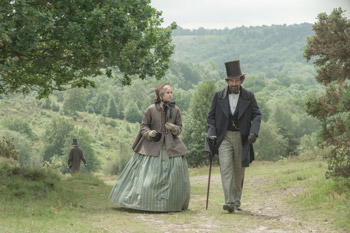 For the look of the film, Ralph Fiennes wanted a rather melancholy palette for the 1870s scenes that book-end the film. Set in Margate in Kent on England's south coast, the exteriors were shot just a few miles away on the commanding sweep of Camber Sands on which Hardy captured a low, wintery light. For the interiors of the Margate school where Nelly lived with her husband and child, Djurkovic translated the look into muted tones and a quiet, subdued aesthetic.
For the look of the film, Ralph Fiennes wanted a rather melancholy palette for the 1870s scenes that book-end the film. Set in Margate in Kent on England's south coast, the exteriors were shot just a few miles away on the commanding sweep of Camber Sands on which Hardy captured a low, wintery light. For the interiors of the Margate school where Nelly lived with her husband and child, Djurkovic translated the look into muted tones and a quiet, subdued aesthetic.
By contrast, the flashback scenes, where Nelly first meets Dickens 15 years before, represent a complete gear-change in colours and atmosphere. 'The early stuff is her memory and her excitement at meeting this extraordinary man," explains Djurkovic. Costume designer Michael O'Connor was able to use photography from the time, as well as the Frith painting and others by Dickens' contemporary Augustus Egg, to explore how the clothes of the time would have been constructed. 'What Ralph Fiennes was keen to do was to use the costumes more than once," says Michael O'Connor. 'There's nothing more unconvincing than people who keep changing all the time. In those days people did wear the same bonnet and re-trim it for a different occasion."
'As an actor, that's what you love," comments Perdita Weeks who plays Nelly's eldest sister, Maria Ternan. 'It doesn't matter if the clothes are a bit smelly or you've spilt something down them. Otherwise you're walking around like a perfect Barbie and if feels completely removed from anything you're doing."
One of Michael O'Connor's biggest challenges was working out what Nelly, the invisible woman, might have worn at two very distinct stages in her life. 'The pictures show this arched kind of woman," he explains. 'But they are later pictures and they are posed pictures. To find the woman who woke up in a cold cottage in the morning and went to the theatre and did a sort of average performance has been very difficult."
Michael O'Connor worked with Felicity Jones to build Nelly's character subtly through costume. 'You think it's just a costume but the detail, every layer is completely accurate as to how it would have been," says Felicity Jones of working with O'Connor.
'Every day I would just see a wonderful Michael O'Connor creation and be totally overawed. You just feel like a real person."
The transformative power of costumes came into play when dressing Kristin Scott Thomas as Mrs Ternan. 'Kristin Scott Thomas will look elegant in anything she puts on and the idea was to make her real, was to try and stop that happening. The temptation with Kristin Scott Thomas is to make her dark and streamlined but in this period of lots of trim and fuss, you can add lots of accessories, trim and lace collars - things that that help go against what is natural for Kristin Scott Thomas says Michael O'Connor.
As in any period drama, the hair and make-up work was very important. 'Putting a centre parting in somebody's head and scraping it down either side of their face when they're used to having curly flouncy hair just immediately transforms you, as does putting on a girdle. It takes you into another period straight away," says Shircore.
'You also have to keep the actors in mind," she continues. 'You have to keep their faces in mind, what suits them in the period, and also what their input is." Most of the shoot took place on location in Kent, and in and around London with just two studio days filming the interior of the railway carriage. The exteriors of the derailment were staged in a siding of the Bluebell Railway, which operates heritage steam locomotives, in Sussex.
As in most of Dickens' novels, all the places described in Abi Morgan's script existed. Location manager Michael Harm started by checking out the real addresses. If they no longer existed or were unsuitable for filming, Hale found matching houses and interiors. The biggest challenge was the contemporary fittings now adorning many of London's Georgian and Victorian houses as well as Dickens' Gads Hill home in Rochester, which had been turned into a school.
'It is an awful lot to do to get rid of all the modern fittings, the beautiful wall- to- wall carpets, the down-lighters, all the modern light switches," says Michael Harm 'So the search has to focus on where we have as little as possible for the art department and the construction department to do to make that work."
For example, although the exterior of Manchester's Free Trade Hall where The Frozen Deep rehearsal took place still looks authentic, the interior had been turned into a modern hotel. Harm and his team discovered the interior could be reconstituted at London's opulent Draper's Hall in the City of London.
As the production was working to a tight schedule, Michael Harm was pleased Ralph Fiennes was willing to jump in a car with him to visit locations on early recces.
'We managed to do an awful lot in a short time," he says. 'Ralph Fiennes is a very visual director, so can describe very clearly what he's after. We were able to narrow down very quickly the ones that worked for him."
'He's incredibly visual," agrees Djurkovic. 'He draws really well and does these amazing storyboards. Lots of directors do their own storyboards but Ralph's are really good!"
For his part, when he took on the project, first as director, then as director and star, Fiennes says he was cheerfully ignorant of most of Dickens' work, ignorant of Ellen Ternan, and hadn't read Claire Tomalin's book.
'Perversely when other people were reading Dickens I would read Dostoyevsky or Tolstoy or other authors," he explains. 'It's one of those things you do when you are young and want to buck a trend. I feel very differently now."
Have You Seen This?
MORE
- Mission: Impossible Fallout
- Glenn Close The Wife
- Allison Chhorn Stanley's Mouth Interview
- Benicio Del Toro Sicario: Day of the Soldado
- Dame Judi Dench Tea With The Dames
- Sandra Bullock Ocean's 8
- Chris Pratt Jurassic World: Fallen Kingdom
- Claudia Sangiorgi Dalimore and Michelle Grace...
- Rachel McAdams Disobedience Interview
- Sebastián Lelio and Alessandro Nivola...
- Perri Cummings Trench Interview

